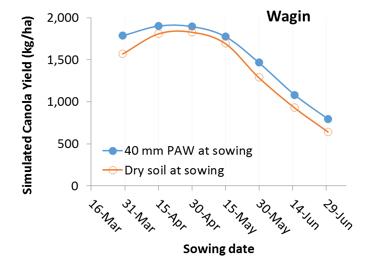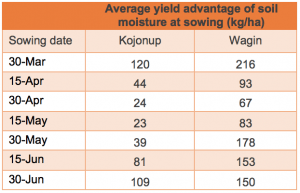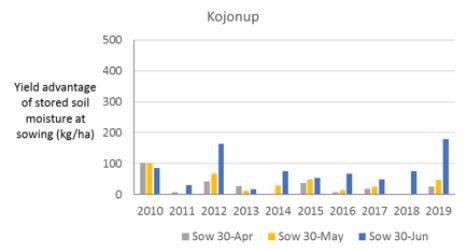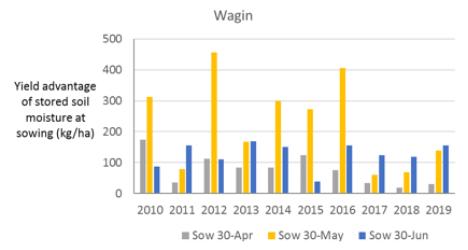By Dr Imma Farre, DPIRD South Perth

Key messages
- In your area, maximum canola yields are achieved with sowings from early-April to mid-May or end-May.
- Stored soil moisture contribution to final yields is variable. The contribution of stored soil moisture to yield is greater in dry seasons and/or lower rainfall locations.
Background
In the last 20 years there has been a significant increase in summer rain in most of the wheatbelt. There is a debate as to how much of the summer rainfall is actually contributing to final yield. Specifically, how much of the summer rain is lost in soil evaporation and how much is stored in the soil to be used later by the crop? We have used the APSIM-Canola model to study the contribution of stored soil moisture at sowing from summer rain to final canola yields.
Canola yield response to sowing date
The APSIM-Canola model was run for the period 1976-2019 using 44 years of local rainfall and temperature data for Kojonup (high rainfall) and Wagin (medium rainfall) for fixed sowing dates from end of March to end of June. Simulations were for a mid-maturity cultivar (ATR Bonito). In the simulations, each sowing date represents a sowing opportunity and therefore the crop germinates immediately after sowing. It is different to dry sowing. Consequently, in this paper, sowing date is equivalent to germination date.
The optimum sowing window in your area, if frost is not an issue, is from early-April to mid-May. Maximum canola yields are achieved, in general, with sowings from early-April to mid-May at both locations (Figure 1). However, the yield decline with delay in sowing after mid-May is more pronounced in Wagin (medium rainfall) than in Kojonup (high rainfall). In high rainfall locations, the yield response to sowing date is quite flat for a wide period, indicating that there is a long period to establish the crop with expected maximum yields. Early sowings (April sowing) in the area have high potential yields provided frost is not an issue. If you are in a frosty location or a frost prone paddock, early sowings could be more impacted by potential frost. Late sowings have higher chances to be negatively impacted by water stress and heat stress.
Stored soil moisture at sowing
The model was run for 2 soil moisture scenarios for each sowing date:
- 40 mm of plant available water (PAW) stored in the soil at sowing (accumulated from summer rainfall) (40 mm PAW at sowing)
- Zero mm of plant available water at sowing, this being soil water content at lower limit (Dry Soil at sowing) (no soil moisture accumulated due to summer rain, due to no summer rain or small rainfall events lost in evaporation)
The long-term yield response to sowing time for Kojonup and Wagin for the 2 scenarios is plotted in Fig. 1.


Figure 1. Simulated canola yields for Kojonup and Wagin for sowings from 30-March to 30-June with cultivar ATR-Bonito. Yields are average for the period 1976-2019. Two soil moisture scenarios: 40 mm of plant available water at sowing (full circle) and dry soil at sowing (open circle).
In Kojonup, on average, there is little yield advantage of having 40 mm plant available soil water at sowing (Figure 1), with yield advantage ranging from 23 to 120 kg/ha (Table 1). In Wagin, where water is more limiting to crop growth, there is a consistent yield advantage of sowing with stored soil moisture for any sowing date (Figure 1) and the yield advantage ranges from 67 to 216 kg/ha (Table 1). Note that these figures are average of 43 years of climate data, and in any particular year the yield advantage can be much smaller or bigger than the long-term average.
Table 1. Long-term simulated canola yield advantage 40 mm of stored soil moisture at sowing (kg/ha) for Kojonup and Wagin with cultivar ATR-Bonito for fixed sowing dates. Simulations are for the period 1976-2019.

Influence of Season Rainfall
There is an important influence of season type to the contribution of stored soil moisture to final yield. The contribution of soil moisture at sowing to final yield, varies from year to year, depending on the amount and distribution of rainfall during the season. If the seasonal rainfall is favourable, there is less contribution of the stored soil moisture to final yield. However, if the season is less favourable and/or you are in a lower rainfall location, the stored soil moisture at sowing can have bigger contributions to final yield. Both the season rainfall amount and the distribution are important for yield accumulation. Table 2 presents the seasonal rainfall for the last 10 years in both locations and Figure 2 presents the yield advantage of 40 mm stored soil moisture in Kojonup and Wagin in the last 10 years for sowings on 30-April, 30-May and 30-June.
In Kojonup, in the last 10 years, the yield contribution from 40 mm of stored soil water was 0 to 190 kg/ha (Figure 2). In Wagin, in the last 10 years, the yield contribution from 40 mm of stored soil water was 300 to 450 kg/ha in half of the years for May sowing (Figure 2).
Table 2. Seasonal rainfall (April to October rain in mm) for Kojonup and Wagin in the last 10 years



Figure 2. Yield advantage of 40 mm stored soil moisture at sowing in Kojonup and Wagin in the last 10 years for sowings on 30-April, 30-May and 30-June.
Comments
Small summer rainfall events will be mainly lost in evaporation. However big summer rainfall events will have part of the rain lost in evaporation and part of the rain stored in the soil profile. The stored soil moisture will be available to crops later in the year and can contribute to final yield. The extent of the contribution of summer rainfall to final yield depends on the date of the break and the growing season rainfall and distribution.
Take home messages
- As a rule of thumb, in the Southern Dirt area (using Kojonup and Wagin climate data), maximum yields are achieved with sowing opportunities from early-April to mid-May. After mid-May any delay in sowing diminishes the yield in medium rainfall locations
- Look at the risk figures to see the chances of achieving a certain yield after a given sowing date. (https://www.agric.wa.gov.au/canola/canola-sowing-time-maximise-yield-western-australia)
- Stored soil moisture contribution to final yields is variable, depending on season type and location.
Acknowledgements
Thanks to GRDC funding, DPIRD and Project team “Expanding Sowing Window of canola and lupins”.

